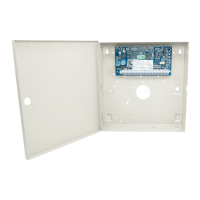Section 5: Programming
Table 5-2 HEX Digit Programming
Value Enter Telephone Dialer
HEX [A]
HEX [B]
HEX [C]
HEX [D]
HEX [E]
HEX [F]
Press [*][1][*]
Press [*][2][*]
Press [*][3][*]
Press [*][4][*]
Press [*][5][*]
Press [*][6][*]
Not supported
Simulated [*] key
Simulated [#] key
Dial tone search
Two-second pause
End of number
The Ready light continues to flash after the HEX digit is entered. If another HEX digit is required press the corresponding
number. If a decimal digit is required, press the [*] key again. The Ready light illuminates and the panel returns to regular
decimal programming.
Example: To enter ‘C1’ for a closing by user 1, enter [*] [3] [*], [1]
[*] to enter hexadecimal mode (Ready light flashes)
[3] to enter C
[*] to return to decimal mode (Ready light is on)
[1] to enter digit 1
If an error is made while inputting data, press the [#] key to exit the section. Select that section again and re-enter the inform-
ation correctly.
When using a Contact ID format, a decimal zero [0] does not transmit for account and reporting codes. Programming a zero
[0] tells the alarm system not to send any pulses for that digit. Decimal zero [0] is a filler digit. To make a zero [0] transmit, it
must be programmed as a Hexadecimal ‘A.’
Example: For the 4-digit account number ‘4032’, enter [4] [*] [1] [*] [3], [2].
[4] to enter the digit 4
[*] to enter Hexadecimal mode (Ready light flashes)
[1] to enter A
[*] to return to decimal mode (Ready light is solid)
[3] to enter the digit 3
[2] to enter the digit 2
- 60 -

